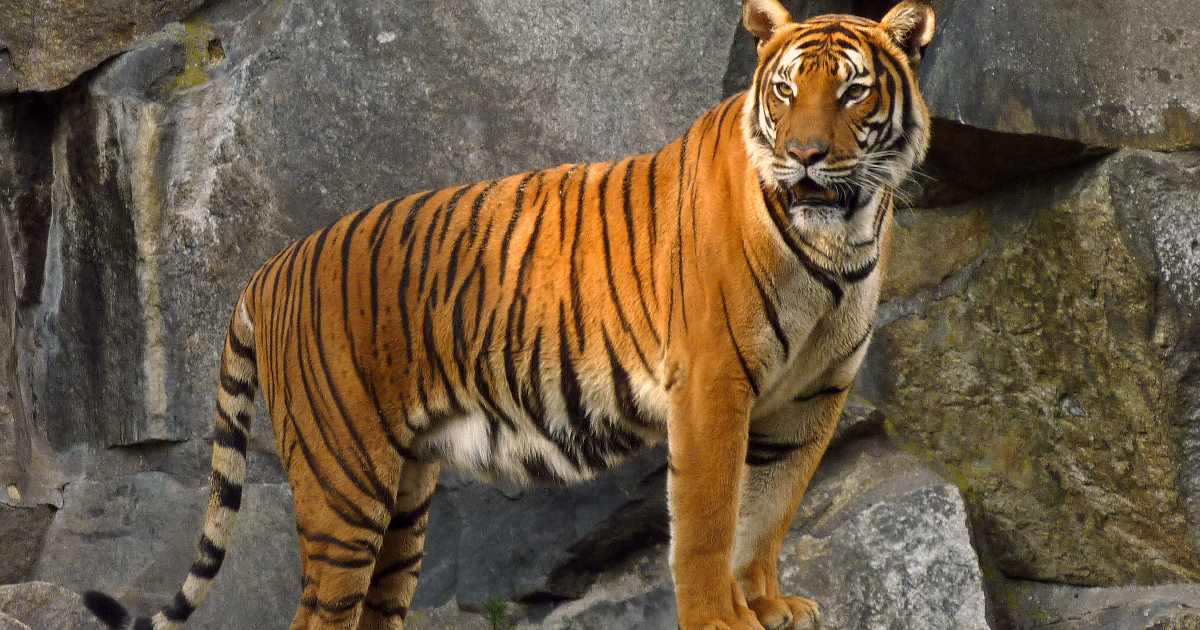
Tigers, the largest of all the big cats, are magnificent and awe-inspiring creatures. Their power, grace, and beauty make them one of the most admired animals in the world. However, these majestic predators are not all the same; they are divided into several tiger subspecies, each with its unique characteristics and habitats.
In this comprehensive guide, we’ll explore the largest tiger species in the world, detailing their sizes, habitats, and key features while naturally incorporating essential keywords related to these incredible animals.
6. Sumatran Tiger (Panthera tigris sumatrae)

- Size: Males weigh between 220-310 lbs and measure 8 feet in length. Females weigh between 165-243 lbs and measure about 7 feet in length.
- Places they can be found: Indonesian island of Sumatra.
- Key feature: Smallest of the tiger subspecies, with the darkest coat and closely spaced stripes.
The Sumatran tiger, the smallest of all tiger subspecies, is found exclusively on the Indonesian island of Sumatra. These tigers have a distinctive appearance, with the darkest coat among tigers and closely spaced, often doubled black stripes. Despite their smaller size, Sumatran tigers are formidable predators, preying on animals such as deer, wild boar, and even smaller mammals.
Conservation efforts for Sumatran tigers are crucial, as they are listed as Critically Endangered on the IUCN Red List. Habitat loss due to deforestation and illegal logging, along with poaching for their body parts, has drastically reduced their population. Indonesia has enacted strict laws to protect these tigers, including severe penalties for poaching.
Additionally, various conservation organizations are working to preserve their habitats and reduce human-tiger conflicts. The survival of Sumatran tigers depends on continued and enhanced conservation efforts to protect their natural habitats and prevent poaching.
5. Malayan Tiger (Panthera tigris jacksoni)

- Size: Males weigh between 220-308 lbs and measure up to 9 feet. Females weigh between 165-245 lbs and measure up to 8.5 feet.
- Places they can be found: Southern Thailand and Peninsular Malaysia.
- Key feature: Identified as a separate subspecies in 2004, smaller in size compared to other subspecies.
The Malayan tiger, identified as a distinct subspecies in 2004, resides in the tropical and subtropical moist broadleaf forests of southern Thailand and Peninsular Malaysia. Named in honor of Peter Jackson, a former chair of the IUCN Cat Specialist Group, these tigers are smaller than most other subspecies. They have a rich orange coat with prominent black stripes, similar to their Indo-Chinese relatives.
These tigers are adapted to the dense and humid forest environments, where they prey on animals like deer, wild boar, and sometimes livestock. Conservation efforts for the Malayan tiger are critical, as they are listed as Endangered on the IUCN Red List.
Malaysia has implemented several measures to protect these tigers, including anti-poaching patrols and habitat preservation initiatives. Despite these efforts, habitat loss and poaching remain significant threats to their survival.
4. South China Tiger (Panthera tigris amoyensis)

- Size: Males weigh between 287 and 386 lbs and measure up to 8.6 feet. Females weigh between 220-254 lbs and measure up to 7.9 feet.
- Places they can be found: Central and Eastern China.
- Key feature: Critically Endangered with very few, if any, individuals left in the wild; known for their shorter and broader stripes.
The South China tiger, also known as the Amoy tiger, is one of the rarest and most critically endangered tiger subspecies. Historically found in central and eastern China, these tigers are now considered functionally extinct in the wild. The South China tiger is characterized by its shorter and broader stripes, which distinguish it from other tiger subspecies. They are smaller in size compared to their Bengal and Amur relatives.
In the mid-20th century, the Chinese government declared these tiger pests, leading to extensive hunting and a drastic decline in their population. By the 1990s, only a few individuals were believed to remain in the wild, with most now living in captivity.
Conservation programs in China focus on breeding these tigers in captivity with the hope of reintroducing them into protected wild areas. The survival of the South China tiger depends heavily on these conservation efforts.
3. Indo-Chinese Tiger (Panthera tigris corbetti)

- Size: Males weigh between 331 and 430 lbs and measure about 9 feet in length. Females weigh between 220-290 lbs and measure about 8 feet.
- Places they can be found: Cambodia, Laos, Myanmar, Thailand, Vietnam.
- Key feature: Smaller and darker with shorter, narrower stripes compared to Bengal tigers.
The Indo-Chinese tiger, also known as Corbett’s tiger, inhabits the dense forests and hilly terrains of Southeast Asia, including Cambodia, Laos, Myanmar, Thailand, and Vietnam. Named after the British hunter and naturalist Jim Corbett, these tigers are smaller and darker than their Bengal counterparts, with shorter and narrower stripes. Their habitats are often remote and difficult to access, making it challenging to study their populations accurately.
These tigers are skilled hunters, preying on various animals such as deer, wild boar, and sometimes livestock. The Indo-Chinese tiger’s habitat preferences include tropical and subtropical forests, which are increasingly threatened by human activities such as logging and agriculture.
Conservation efforts are in place, but habitat destruction and poaching continue to pose significant challenges to their survival. The exact number of Indo-Chinese tigers remaining in the wild is uncertain, but they are listed as Endangered on the IUCN Red List.
2. Indian (or Bengal) Tiger (Panthera tigris tigris)

- Size: Males weigh between 389 and 475 lbs and measure up to 10.2 feet. Females weigh between 220-350 lbs and measure up to 8.7 feet.
- Places they can be found: India, Bangladesh, Nepal, and Bhutan.
- Key feature: Vibrant orange coat with distinctive black stripes, some exhibiting a rare white coloration due to a recessive gene.
Bengal tigers, or Royal Bengal tigers, are the most numerous of all tiger subspecies. These magnificent creatures predominantly reside in India, with smaller populations in Bangladesh, Nepal, and Bhutan. Their striking orange coat with bold black stripes makes them easily recognizable.
In rare cases, Bengal tigers may possess a recessive gene that gives them a white coloration, creating the famous white tiger variant, although these are seldom found in the wild. Bengal tigers thrive in diverse habitats, including dense forests, mangroves, grasslands, and temperate forests. They are solitary hunters, preying on animals such as deer, wild boar, and occasionally sloth bears.
Conservation efforts have been relatively successful in India, where numerous tiger reserves and national parks have been established to protect their natural habitats. Despite these efforts, Bengal tigers remain endangered due to habitat loss, poaching, and human-wildlife conflict.
1. Amur (or Siberian) Tiger (Panthera tigris altaica)

- Size: Males weigh between 389 and 660 lbs and measure up to 11.5 feet. Females weigh between 260-303 lbs and measure up to 9.8 feet.
- Places they can be found: Russian Far East and parts of Northeast China.
- Key feature: Paler orange fur with brown stripes, white chests, and a ruff of fur around their necks.
Amur tigers, also known as Siberian tigers, are the largest of all tiger subspecies. They inhabit the cold forests of the Russian Far East, extending into Northeast China. These tigers have adapted to harsh winter conditions, showcasing thicker fur and a layer of fat that insulates them against the frigid temperatures.
Amur tigers stand out with their paler orange coat and brown stripes, as opposed to the black stripes found on other tiger subspecies. Their robust build and substantial size make them formidable predators in their environment. Living primarily in remote and rugged terrains, Siberian or Amur tiger has vast territories that they roam in search of prey, such as wild boar and deer.
Conservation efforts are critical for this subspecies, as they are listed as Endangered on the IUCN Red List. Protected areas have been established along the Russia-China border to safeguard these tigers and promote population recovery. Zoos worldwide also participate in breeding programs to help maintain healthy genetic stocks and boost the population of Amur tigers.
Conclusion
Tigers are not only the largest but also some of the most fascinating and iconic predators in the animal kingdom. Each tiger subspecies, from the enormous Amur tiger to the diminutive Sumatran tiger, possesses unique characteristics and faces specific conservation challenges. Understanding these wild tigers’ differences is crucial for their preservation.
Tiger conservation efforts worldwide strive to protect these magnificent creatures and their habitats, ensuring that future generations, especially a female tiger, can continue to marvel at the largest tiger species in the world. By supporting these initiatives, we can help safeguard the future of wild tiger populations and the biodiversity of our planet.
Frequently Asked Questions (FAQs)
What is the largest tiger species ever to exist?
The largest tiger species ever to exist was the Amur or Siberian tiger (Panthera tigris altaica). Males weigh between 389-660 lbs and measure up to 11.5 feet. These tigers were historically found in the Russian Far East, parts of China, and North Korea. They are renowned for their size, strength, and ability to survive in harsh, snowy environments.
Which is bigger, a Siberian or Bengal tiger?
Siberian tigers (Panthera tigris altaica) are generally larger than Bengal tigers (Panthera tigris tigris). Adult male Siberian tigers can grow up to 10.5 feet in length and weigh up to 660 pounds, while male Bengal tigers typically reach up to 10 feet and weigh up to 500 pounds. The larger size of Siberian tigers helps them endure the cold climates of their natural habitat.
Are Siberian tigers bigger than African lions?
Yes, Siberian tigers are generally larger than African lions. Male Siberian tigers can weigh up to 660 pounds and measure up to 10.5 feet in length. In contrast, male African lions typically weigh between 330 and 550 pounds and measure around 8 to 10 feet in length. The greater size and weight of Siberian tigers give them a physical advantage over African lions.
What is stronger than a Siberian tiger?
In regions where Ussuri brown bears and Siberian tigers coexist, Ussuri brown bears have been known to kill tigers in conflicts. The brown bear is larger and heavier, often weighing up to 1,500 pounds. Additionally, the gaur or Indian bison, a massive and aggressive animal, can also pose a significant challenge to a Siberian tiger due to its size and strength.
What is the deadliest tiger in the world?
The deadliest tiger in the world is often considered the Bengal tiger (Panthera tigris tigris). Historically, certain Bengal tigers, like the infamous Champawat tigress, have been responsible for a high number of human fatalities. These man-eating tigers often resort to hunting humans due to injury, old age, or loss of natural prey, leading to their fearsome reputation.

